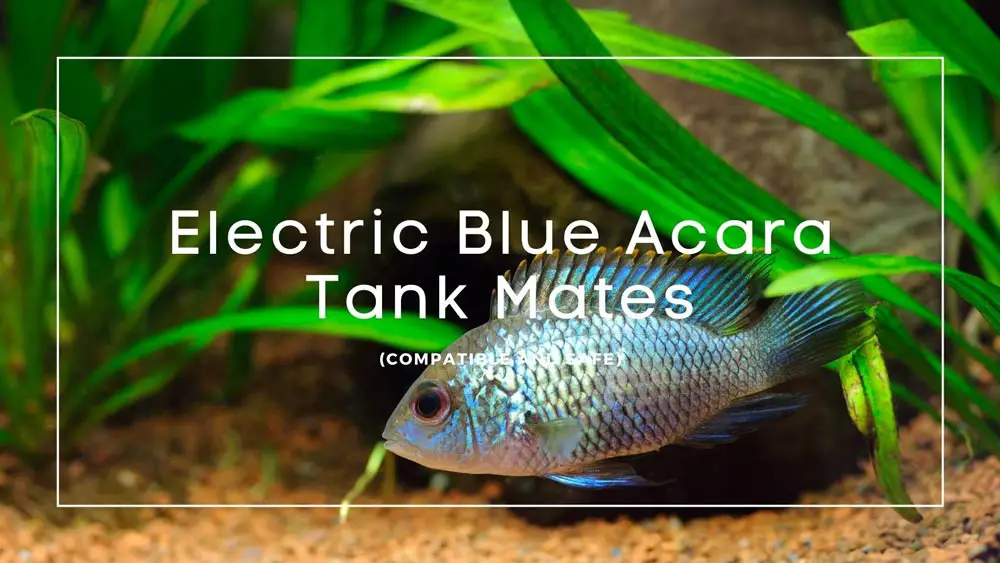If you have a tank of South American cichlids, the electric blue acara is one dream fish that might fill your needs. This fish has beautiful looks, and it’s less aggressive than most other cichlid species- making this an ideal choice for community tanks with similarly sized friendly neighbors!
You have a lot of options when it comes to choosing suitable electric blue acara tank mates. They’re peaceful and will avoid starting trouble with other fish, so they’ll probably get along well in any community aquarium!
What Kind of Fish Can You Keep with Electric Blue Acara
If you’ve found a cool freshwater fish and wondered if it would go well with your Electric Blue Acara, this is where to start:
- Avoid most African species. They are too aggressive for the electric blue acara.
- A breeding pair might get quite aggressive with tankmates
- Stick to similar-sized community fish. Stay away from small and spiny fish.
- Choose tank mates that can live in the same water conditions.
- ALWAYS consider the tank size and your EBA personality.
7 Best Electric Blue Acara Tank Mates
The following are our top 7 tank mates that are compatible with Electric Blue Acaras
Cory Catfish
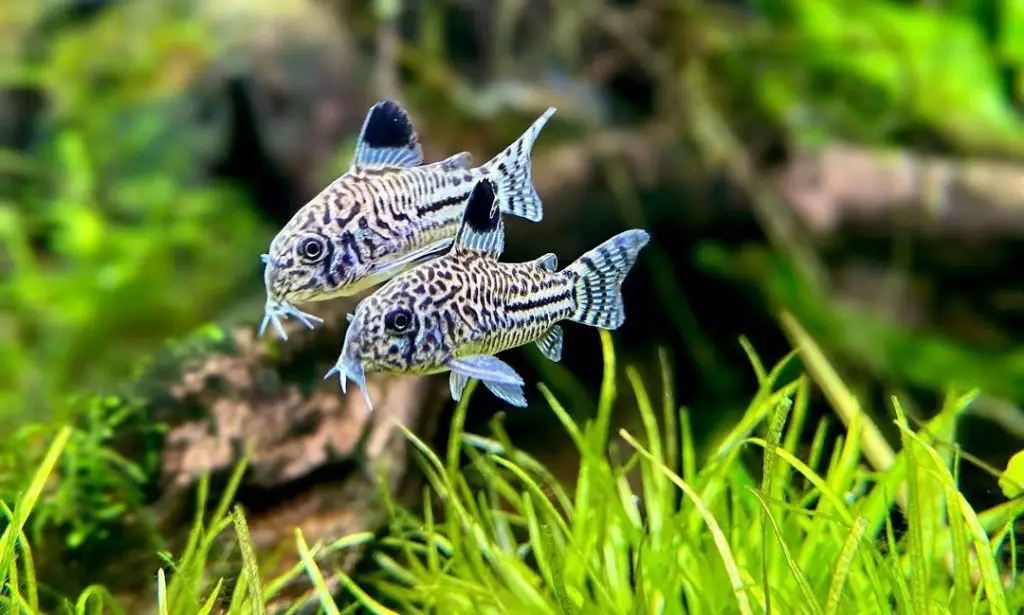
Native to South America, Cory catfish are one of the most popular bottom-dwelling scavengers for freshwater aquariums. They thrive in a wide range of water conditions and stay relatively small makes them perfect for a smaller community you’re running!
Cory Catfish can be active during the daytime hours, and they are most active at dawn and dusk. Sometimes, they are often seen resting motionless in a single spot for hours.
Cory catfish, like all catfish, spend most of their time at the bottom of the aquarium to find food, which can help keep your tank clean. Keep these creatures happy by having a soft sand substrate on the bottom to provide them with their natural habitat and plenty of room for exploring!
| Origin: | South America |
| PH: | 6.2–7.2 |
| Temperature: | 68–78°F |
| Family: | Callichthyidae |
| Size: | Varies up to 4-1/2″ |
| Temperament: | Peaceful |
| KH: | 5-18 |
| Care level: | Easy |
| Color form: | Varies |
Bristlenose Pleco
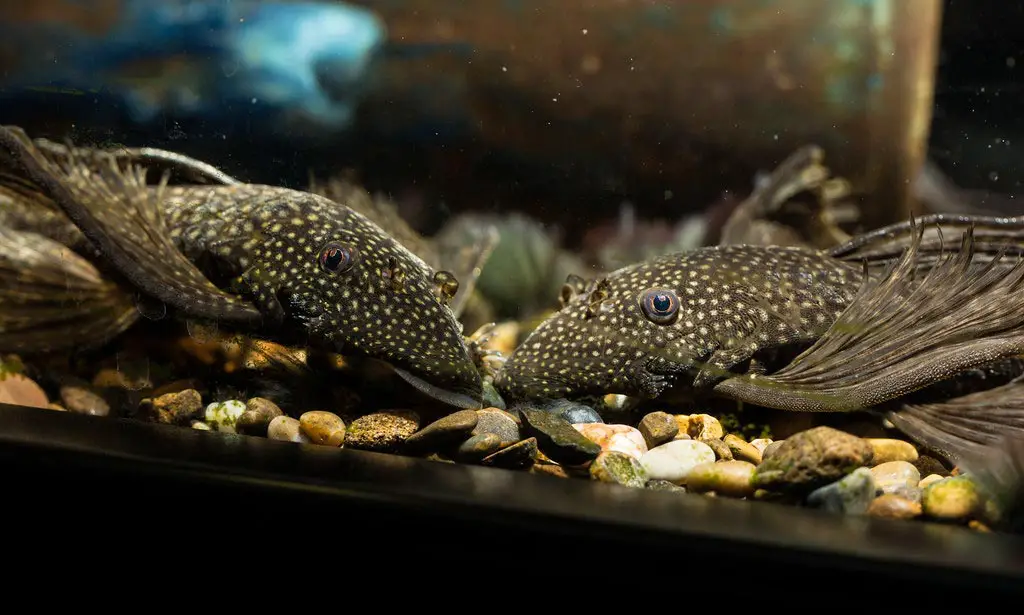
Bristlenose Plecos, which also originates in South America, are the perfect creatures for any aquatic enthusiast, especially if you’re just starting out. Not only do they look cool, but their skill at keeping algae away makes them a valuable addition to any tank.
Some Bristlenose Plecos are strikingly beautiful with brown, olive, or gray bodies with white or yellow spots. Some can be found in uneven coloring, with lighter or darker splotches across various parts of the flattened body.
Bristlenose Plecos are low-maintenance peaceful bottom dwellers. They are easy to care for and can tolerate a wide range of conditions which makes them perfect for getting along well with many types of tank mates.
| Common Name: | Bushy Nose Pleco |
| Scientific Name: | Ancistrus spp |
| Family: | Loricariidae |
| Origin: | South America |
| Care Level: | Easy |
| Size: | 4 – 5.9″ |
| pH: | 6-8 |
| Temperature: | 68-77°F |
| KH: | 6 – 10 dKH |
| Lifespan: | 3-4 years |
| Minimum tank size: | 30 gallons |
| Diet: | Herbivore |
| Temperament: | Peaceful |
Buenos Aires Tetras
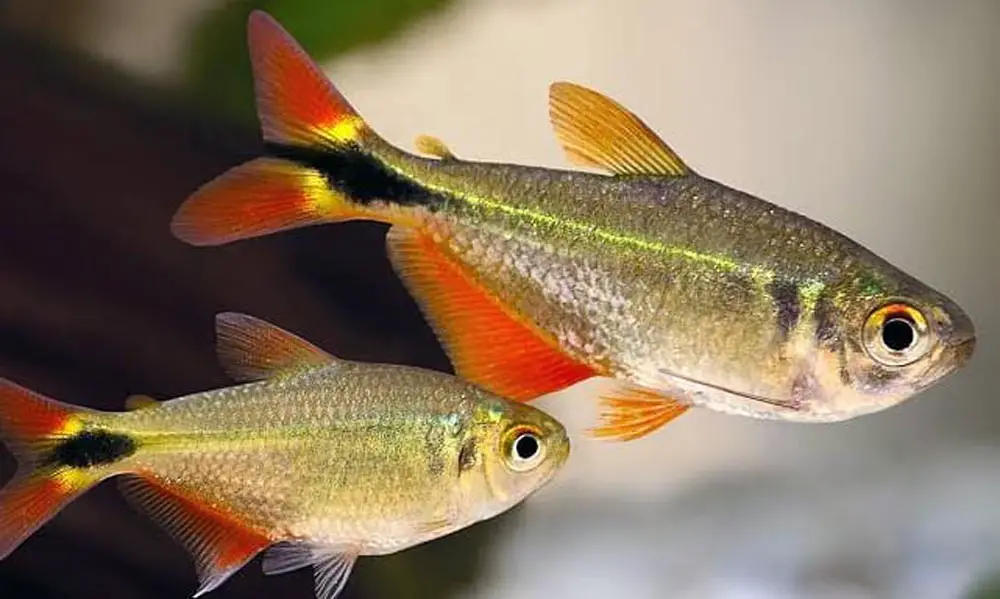
The Buenos Aires Tetra is hardiness and ease of care that make it very popular. The fish derives its name from the capital city of Argentina. You can find them in rivers, streams, and lakes branching out into the Río de la Plata, located on the southeastern coast of South America.
A Buenos Aires Tetra’s unique coloration is what sets them apart from other types of tetras. It has a slender silver body, red fins with a thin blue stripe that extends from behind the gill plate and ends at the tail fin. When light hits this stripe, it will appear as though they are shimmering in every color imaginable! One of the most popular varieties, Albino Buenos Aires Tetra, has been bred with a yellow tail. They are amazing and fun to watch.
Buenos Aires Tetras are active schooling fish. They crave safety in numbers, so a group of six or more fish of the same species is highly suggested.
Probably the essential part of caring for your Buenos Aires Tetras is replicating the water temperatures of their natural habitat in Argentina. You should keep them in a clean environment with regular water changes. This way, the fish is less likely to suffer from nitrates and phosphates as well as high levels of hardness due to evaporation.
Pro tip: Don't keep Buenos Aires Tetras in live planted tanks because they will eat most live plants. I strongly recommend using artificial plastic plants instead, or sturdy plants such as Java fern.
| Scientific Name: | Hemigrammus caudovittatus |
| Family: | Characidae |
| Origin: | Argentina, southeastern Brazil, Paraguay |
| Color Form: | Red, Silver |
| Care Level: | Easy |
| Size: | 2.75″ |
| pH: | 7.0-8.3 |
| Temperature: | 64-82°F |
| KH: | 12-30 dKH |
| Lifespan: | 5 years |
| Minimum tank size: | 10 gallons |
| Diet: | Omnivore |
| Temperament: | Peaceful |
Lemon Tetras
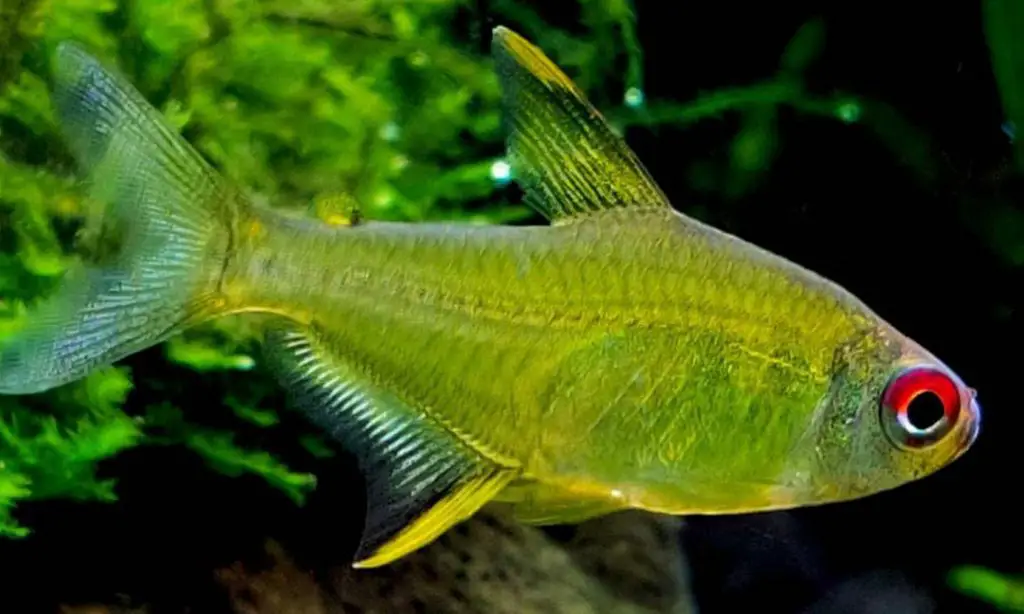
For many years, Lemon Tetras were one of the most popular fish in aquariums. Native to South America, they are highly coveted for their bright coloration and hardiness – this species can live in almost any water parameters the common hobbyist maintains.
The bright yellow coloration of the diamond-shaped body adds to its popularity. In most specimens, they have a semi-transparent body and pearlescent scales. A triangular, semi-transparent dorsal and anal fins with splashes of yellow and black covered can add a special pinch of color to any community aquarium.
When creating a habitat for your Lemon Tetras, remember that their native environment is one of the shallow streams with soft and clean water. Unlike many other species of Amazonian fish, lemon tetras can live just fine without tannin-infused habitats.
| Scientific Name: | Hyphessobrycon pulchripinnis |
| Family: | Characidae |
| Origin: | South America |
| Color Form: | Yellow |
| Care Level: | Easy |
| Size: | 1.4 – 1.6″ |
| pH: | 5.0 – 7.5 |
| Temperature: | 68 – 82°F |
| KH: | 3 – 12 dKH |
| Lifespan: | 4-8 years |
| Minimum tank size: | 20 gallons |
| Diet: | Omnivore |
| Temperament: | Peaceful |
Bolivian Ram
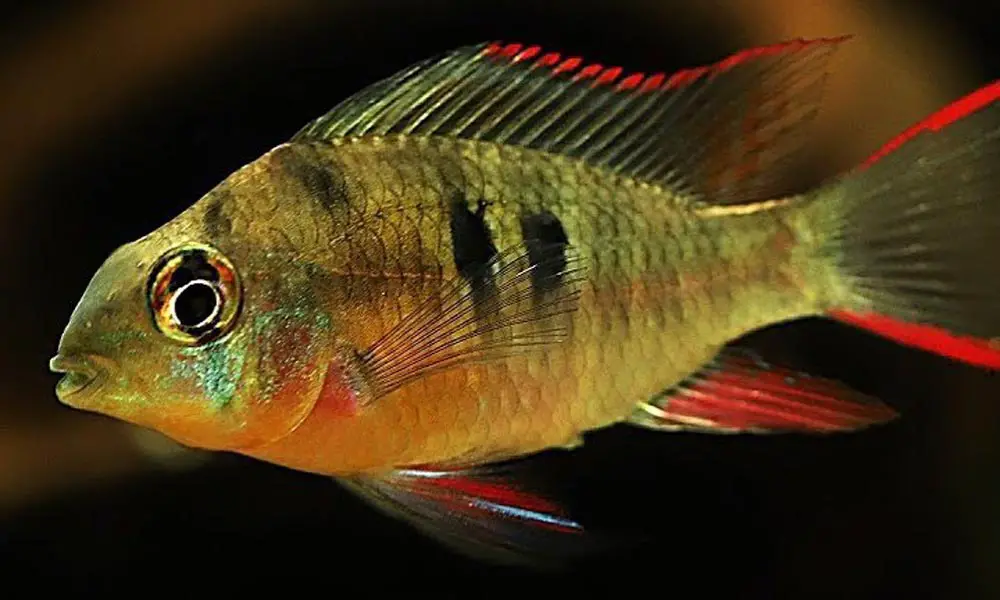
If you are looking for a fish that is shyer than the average community tank resident, then Bolivian rams might be right up your alley.
Bolivian Ram, also called the Butterfly Ram and the Red Ram, native to South America, are a striking and colorful addition to any home aquarium. They sport yellow, red, and silver blue colors that will definitely stand out among other fish in your tank!
They also have endearing swimming behaviors such as head-standing and “waving” their fins at you, which makes them well worth adding to your collection of aquatic life.
It is best to mimic their natural environment to ensure that your Bolivian Rams thrive in an aquarium. You’ll need to give them the right water conditions to replicate their natural habitat. They also enjoy lots of plants in their tank, so make sure that there are sufficient plant groups as well as open swimming spaces with rocks, driftwood, or other things they can hide behind while exploring the great big world inside their home!
| Scientific Name: | Mikrogeophagus altispinosa |
| Family: | Cichlidae |
| Origin: | Bolivia, Brazil, South America |
| Color Form: | Tan |
| Care Level: | Expert Only |
| Size: | 3″ |
| pH: | 6.5-7.5 |
| Temperature: | 72-79°F |
| KH: | 0 – 10 dKH |
| Lifespan: | 4-8 years |
| Minimum tank size: | 30 gallons |
| Diet: | Omnivore |
| Temperament: | Peaceful |
Gold Barb
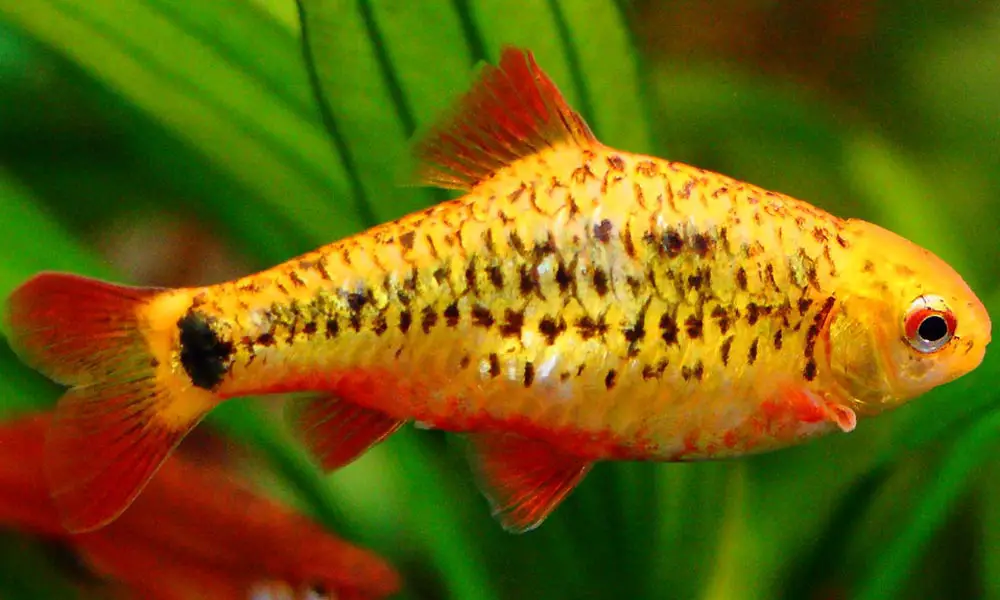
The Gold Barb originates from the Red River basin in China, Taiwan, and Vietnam, also known as the Chinese Barb. They have a mostly gold-colored body with small, dark, or black patches running down the lateral line.
The gold barb is one of the most popular schooling fish and should be kept in groups of at least 6 or more. They are peaceful, making them an excellent choice for community aquariums with other similarly sized peacekeeping fishes.
An adaptable fish, Gold barb fish, isn’t picky about water conditions or habitat essentials. It is a freshwater species that do well in colder water and can be kept in an unheated tank! Avoid keeping them with a planted tank because they may nip at the plants.
| Scientific Name: | Puntius semifasciolatus |
| Family: | Cyprinidae |
| Origin: | Red River Basin China, Taiwan, Vietnam |
| Color Form: | Gold with black spots |
| Care Level: | Easy |
| Size: | 3″ |
| pH: | 6.0-8.0 |
| Temperature: | 64-75°F |
| KH: | 4-10 dKH |
| Lifespan: | 5-7 years |
| Minimum tank size: | 20 gallons |
| Diet: | Omnivore |
| Temperament: | Peaceful |
Congo Tetra
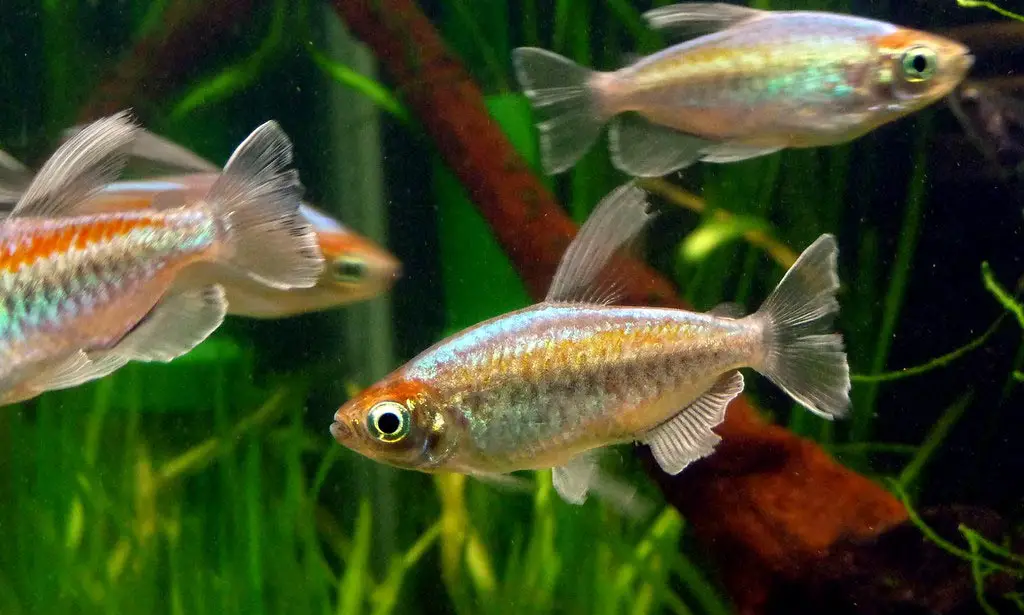
The Congo Tetra is considered by many aquarists as the jewel of tetras no matter you’re a beginner or an expert looking for a pretty beautiful addition to the home aquarium.
Congo Tetras are a species of fish in the African tetra family that are shaped like typical tetra. They have large scales on their bodies which make them appear more compressed than other fishes. When they get older, this iridescent fish boasts a captivating rainbow appearance. When fully matured, these iridescent scales provide an almost magical color spectrum that shifts between blue and gold to violet or turquoise depending on where light reflects off their bodies.
Pro tip: You should never keep congo tetras with any species with a penchant for nipping fins because the males' spectacular fin will be destroyed. They also shouldn't be kept with boisterous tankmates, as they are shy fish and not suited to such environments.
If that wasn’t enough, Congo Tetras are easy to care for, but only if provided with the correct habitats and water conditions.
| Scientific Name: | Phenacogrammus interruptus |
| Family: | Alestidae |
| Origin: | Congo River Basin |
| Color Form: | Orange, White, Yellow |
| Care Level: | Moderate |
| Size: | 3″ |
| pH: | 6.0-6.2 |
| Temperature: | 75-81°F |
| KH: | 4-8 dKH |
| Lifespan: | 3-5 years |
| Minimum tank size: | 20 gallons |
| Diet: | Carnivore |
| Temperament: | Peaceful |
Conclusion
By following our guidelines and examples laid out above, you might find there are many other tank mates who have similar needs and can thrive in a community aquarium with your Electric Blue Acara.
Consider things like water temperature, pH levels, tank size, and aggression level of potential tank mates before making a decision so that you know they will live peacefully together for years to come.
I hope this has been helpful! Anyone else has more for Electric Blue Acara tankmates? Comment them below!
